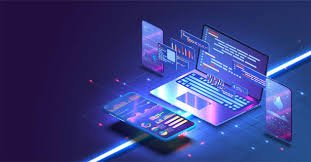Technology is changing at a faster pace than ever, bringing in fully new features and mobile app development approaches. The ever-increasing competition in the industry pressures modernized firms to integrate the newest technologies into their mobile apps fully.
Companies should quickly adapt to these changes. The rate of digital transformation, customer loyalty, and overall satisfaction are directly proportional to how optimized mobile interfaces are. With the rest of the world leveraging 5G mobile applications, AI personalization features, and improved user interfaces and experiences, companies sure have to keep up with their speed.
Considering the boom of 5G, AR, and AI technology and the increasing importance of UX design for mobile apps, this article touches on the principal trends for mobile app development for the year 2025. Not only do companies allow themselves to become Mobile Application-optimized and competitive, but by paying attention to the stated trends, they also ensure new opportunities will open.
With the custom mobile app development in technology and rising demands of mobile users, experts predict that by 2025, 5G systems will be embedded into the world digital system. This would be a remarkable advancement in the functionalities and applicability of mobile applications. For mobile app developers, the presence of 5G technology will ease their work with remarkable speed, efficiency, as well as better integration with other technologies.

5G’s Impact on Mobile App Development

The rollout of 5G technology has been one of the most anticipated technology improvements in recent history. It is forecasted that by 2025, 5G systems will be fully incorporated into the global digital infrastructure, changing the landscape of how mobile applications operate and the experiences they offer their users. The presence of 5G in mobile app development will bring with it unprecedented speed, efficiency, and better integration.
Speed and Connectivity:
One of the key benefits of custom mobile applications using 5G is speed. Data transmission using 5G technology is expected to be up to 100 times faster than 4G, which also leads to almost nonexistent loading times. As a result, mobile apps can now serve high-quality 4K and even 8K videos without any form of buffering.
Businesses can use the capabilities unlocked by 5G technology to develop mobile applications that enable everything from collaborative tools to cloud gaming applications. Responding to user input will be instantaneous, eliminating the delays that significantly diminish the enjoyment of using mobile applications.
Enhanced Cloud Computing Capabilities:
The wide reach and data allowance of 5G mean apps will work well with cloud infrastructure. With the high levels of cloud connectivity, custom mobile application development will reach out and retrieve data from the cloud. This can be done at much faster speeds, making the need for device storage and other hardware components less important.
This shift will motivate businesses to create custom mobile applications that are not only lighter and optimized, but can also be used on multiple devices. The users will be able to access cloud-based mobile applications, which will enable them to enjoy high-end performance without any high-quality smartphones.
Real-Time Interactivity And Low Latency:
One of the biggest problems with 4G mobile technology was latency, or the time taken to send and receive data. With 5G operating, latency has effectively been compressed to a mere 1 millisecond, making real-time interactions achievable and practical. This development will result in a positive impact on applications that involve gaming, medicine, finance, and many more.
For example: Multiplayer gaming applications will allow users to play in real-time with other players without experiencing lag. Telemedicine apps will smoothly facilitate remote consultation in real time without interruption. Stock trading applications will place trades as soon as the button is pressed, which minimizes risks for the investor.
The Internet of Things and Smart Devices:
Mobile applications that harness the IoT ecosystem will also be enhanced by 5G technology. Mobile applications will easily interface with smart home gadgets, wearables, and industrial sensors. This is achievable due to the ability to link millions of IoT devices concurrently.
Real-time monitoring, predictive analytics, and application-to-device interoperability will empower healthcare, logistics, and automation businesses with 5G-enabled custom mobile applications.
Increased Protection Against Cyber Threats and Data Breaches:
Faster connection speeds raise security possibilities, and 5G is no different. Mobile applications become easier to protect from cyber-attacks with 5G’s advanced encryption and security health features. Through 5G, businesses are able to improve the protective features of mobile apps.
Augmented Reality (AR) and AI in Mobile App Development
We can expect everything from personalized AI automation to visual AR experiences. This is changing the future of mobile applications promises to be more advanced than ever imaginable. Let us delve deeper into the transforming worlds of mobile app development. These are transforming rapidly due to AI and AR and how different sectors are changing.

Augmented Reality
1. AI-Powered Personalization for Mobile App Development
Powerful marketing tools and mobile app developers have been able to adapt to the latest age technologies. This helps in identifying customers, understand their pain points, and maximize value. Thanks to AI, mobile app development now uses algorithms to examine user activity, targets, and their live interactions.
How AI Personalization Works in Mobile Apps?
A mobile app combines data on interaction patterns, such as search records, application launches, and surfing activities. This helps to devise ways of delivering options and solutions during an interaction.
For instance: A streaming application gathers a lot of data on an individual’s watching and listening habits. Then, it suggest what they should listen to or watch next; this is true for Netflix and Spotify.
An e-commerce website evaluates consumers’ buying and even spooking behaviors. Then, it streams suggestions on products to purchase, such as on Amazon or eBay. Even finance applications are able to provide AI-driven financial advice to individual users on how to budget, and monitor spending. This even make suggestions for how to personalize investments. Mobile CRM development is now equipped with AI personalization features that are smarter, adaptable, and very efficient. It enhances the user experience and business revenue.
The Gains from AI in Custom Mobile App Development
- Boosts User Engagement: Personalized experiences motivate users to engage more and more with mobile applications. This makes them very captivating and addictive.
- Increased Sales: AI recommendations allow companies to increase their revenue. It suggests products or services that are relevant to the customers.
- Increase Client Retention: App userso come back to your application when their preferences are catered to.
- Real-Time Adaptation: AI shifts with the user’s behavior and improves their suggestions, leading to an enhanced experience.
As the technology for AI advances further, mobile app development will continue to be more precise and intuitive. Thus making personalization a salient characteristic to have by 2025.
2. Augmented Reality (AR) That Improves User Experience
With the introduction of augmented reality (AR) technology, mobile applications are not only available to phone users. It’s predicted that AR mobile apps will dominate retail, real estate, healthcare, education, gaming, and many other fields by the year 2025.
The Role of AR in Transforming Mobile App Development
Mobile app development is now enhanced through AR technology by placing virtual objects, animations, and other interactive features in a user’s real-life surroundings, causing enjoyment that leads to better engagement, visualization, and decision-making.
How Different Sectors Utilize Augmented Reality?
Retail & E-commerce
Using augmented reality fastens the mobile CRM development process, retailers can enhance the experience of consumers shopping online through mobile apps. Users no longer must base their purchases on still photographs because they can try products for free prior to making a payment.
A case in point:
- The IKEA Place app allows customers to see how the furniture would fit in their homes before making any purchases.
- The Sephora Virtual Artist app enables clients to test various make-up items using the AR interface.
- Nike Fit lets customers scan their feet to find out the correct size of shoes they need, and augmented reality does the rest.
Shopping will become even more automated and customer-friendly as 5G networks facilitate faster data processing.
Real-estate and Architecture
Buyers and investors in real estate have increasingly used augmented reality in mobile app development to make better, more calculated decisions. Through AR-powered smartphone apps, users no longer have to travel to numerous properties. Instead, they can enjoy virtual property tours.
- Zillow and Realtor.com are both examples of apps that allow users to view homes in 3D.
- Real estate agents are able to present architectural designs to clients using augmented reality mobile apps.
- Before physically changing the interiors of a house, homeowners can now use augments to redesign and decorate their spaces.
The augmented reality technology used in real estate practically eliminates the need for guesswork, making the entire process of buying and designing property much more interactive and easier.
Medical Industry
- AccuVein is changing the game in medical education by using augmented reality technology to locate veins for injections on a 3D model displayed on mobile devices.
- Mobile applications in medicine enable more accurate diagnosis and treatment, therefore improving practitioners’ health and effectiveness.
Other Industries
Due to discoveries made by Google and NASA, the mobile app development sphere has advanced greatly. Google Expeditions AR lets students participate virtually with historical landmarks and scientific processes.
- An example of this would be NASA’s AR programs that let students actively engage with portions of outer space.
Augmented reality systems and technologies can create absolutely realistic and compelling visuals, making them perfect for educational purposes. They not only offer diversity but also enable information to be depicted in various forms and ensure that they cater to students’ different learning approaches. Mobile app development will be enhanced and made more interactive and lifelike with the availability of far faster mobile communications enabled by 5G and augmented reality technology. Providing interactive mobile experiences puts businesses ahead of their competitors and increases usability.
3. The Use of AI Chatbots and Virtual Assistants in Mobile Application Software
AI chatbots and voice assistants are very useful in mobile CRM development, and they work to solve problems, meet customer needs, and manage user activity by giving prompt attention even in the absence of personnel support. These tools—chatbots—help in customer support, automate responses, and increase user interest.
AI Chatbots in Mobile Applications
AI chatbots are versatile and simple applications that utilize Natural Language Processing (NLP) to comprehend and answer particular queries. Chatbots can be accessed and utilized in:
- Banking and Finance Applications: Erica (Bank of America)-powered AI chatbots help users to transact, manage accounts, and budget in an easier way.
- E-commerce Applications: With the use of primary customers AI-powered chatbots are in use in Amazon and eBay apps; the chatbots help the users in searching products, order tracking, and customer support management in a more efficient manner.
- Healthcare Applications: Initial medical suggestions can be offered by Ada and Babylon Health AI-driven symptom checkers.
But the most popular are AI-powered chatbots and mobile applications, and they increase the response by a factor of 10 per time and provide user satisfaction with 24/7 support.
Virtual Voice Assistants Integrated in Mobile Application
Mobile programs like Google Assistant and Siri are commonly used together with Alexa virtual voice chat programs. Users can now:
- Control their smart devices
- Set important reminders and alarms
- Search on the internet with no need for manual control
- Schedule appointments and send messages
With the increasing number of people using mobile phones powered with AI chatbots and other mobile applications integrated with voice-activated AI-powered assistants, easy navigation and affordability for use with ease by 2025
The Collaboration of AI and AR Technologies in Mobile Apps
The fusion of AI and AR technologies in mobile app development will deliver unparalleled user experiences. Here is how it is done:
- AI-Enabled Social Media Filters: Snapchat and Instagram social media applications enhance user experiences by applying AI and AR filters during interactions.
- AR-Enhanced Smart Wayfinding: Google Maps Live View employs AI and AR technologies to superimpose street directions on the actual streets.
- AI-Integrated AR Shopping Helpers: The shopping assistants in augmented reality use AI to suggest items and AR to visualize the items in real-time.
The integration of AI’s smart capabilities and AR’s interactivity will allow mobile CRM development in 2025 to achieve effortless, intelligent, and breathtakingly beautiful experiences.
The Relevance of UX/UI Design in Mobile Development
All the changes that have been made in mobile applications with 5G, Artificial Intelligence (AI), and Augmented Reality (AR) have come with user expectations of a more personalized experience. Businesses that incorporate user experience and interface design are likely to improve their user retention, user engagement, and conversions.
1. Simple and Easy to Use Mobile Application User Interface
Mobile apps are preferred to be visually appealing and easy to use. An app that is complex is not preferred by the users to navigate, which causes the user to abandon the application. In 2025, mobile app development services will focus on aesthetic aspects of practicality, where simple design and functionality will dominate.
Considerable Aspects of Minimalist UI in Mobile Applications:
- Clear Design: An organized and clear structure will enable users to find everything they need easily.
- Clean Typography: Readable fonts with appropriate spacing ensure mobile applications are easier to read and use.
- Clear Icons: Differently shaped icons that are easily recognized will make mobile app navigation better.
- Seamless Transitions: Subtle animations that allow for constant interaction will enhance the mobile application.
Why Minimalist UI is Important for Mobile Applications
- Improves User Experience: Better user engagement comes from a well-designed mobile application.
- Reduces Mental Effort: Users need less time to process information in a clean interface.
- Enhancements in Speed and Performance: Loading designs that are lightweight improve the overall efficiency of the app since it can be loaded much faster.
- Improvements in Boosting Conversions: Maintaining a user-friendly mobile app helps retain customers as well as improve conversion rates.
As users expect fast, efficient interactions, simplicity in UI design is a must for businesses that want to remain competitive.
2. Mobile Apps with AI UX Personalization
Hyper-personalized experiences are now more user-friendly among mobile applications due to new technology AI. In 2025, responsive UI/UX design services will make web and mobile app development more familiar to users by learning their preferences in real time. Mobile apps will become more engaging and tasking when users see the need to perform tasks as opposed to completing them.
How can AI Help with UX in Mobile Applications?
- Predictive Analytics: AI suggests appropriate information based on the user’s activities.
- Adaptive Interfaces: Mobile applications transform theme, layout and even the style of navigation used according to the user’s liking.
- Personalized Notification: The AI alert system increases user engagement while not seeming overbearing.
- Chatbots & Virtual Assistants: Bots support a user with mobile applications, making it easy to scan for and locate information.
Examples of AI-Powered UX Personalization in Mobile Applications
- Netflix & Spotify: AI serves users with content recommendations that are tailored for them based on what they have done in the past.
- Amazon & eBay: AI recommends items aligned with a user’s purchasing behavior.
- MyFitnessPal & Fitbit: AI monitors one’s actions and varies the suggested physical activities.
Advantages of AI-Powered UX in Mobile Applications
- Heightened User Engagement: Engaging with AI is an experience within itself. Having personalized experiences will make users feel that they are appreciated and will encourage them to engage further in using the device’s application.
- Improved Retention Rates: Once users of mobile applications have become accustomed to a certain interface design, they are very likely to return back to it.
- Better Decision Making: AI enables a business to understand its users and strategically work towards mobile application development.
Focusing on AI-driven personalized services, companies can perform mobile app development process that is perceived as being additional intelligent, reactive, and user-oriented.
3. Mobile Application Dark Mode and Adaptive UI
Mobile apps have adopted dark mode as it gives an edge in their visual attraction as well as cuts down on eye strain and enhances battery life. In the upcoming year of 2025, users will see an influx of mobile apps that implement dark mode and adaptive UI for added user convenience.
Reasons for Dark Mode’s Popularity in Mobile Apps
- Reduction of Eye Strain: Dark mode enables the users to glare less and focus easily while using mobile devices, especially at night.
- Improved Battery Use: Battery consumption is reduced when devices with OLED and AMOLED screens are in dark mode.
- Visual Enhancement: Dark mode gives mobile applications a streamlined feel, making UI modern aesthetics appealing.
What is Adaptive UI in Mobile Applications?
The responsive UI/UX design services of Adaptive UI for mobile applications caters to a number of different factors that could impact the appearance of the App Interface. these factors include:
- Type of device in use (smartphone, foldable screens, tablet)
- Resolution and size of the screen
- Lighting conditions (automatic switching between dark/light mode)
- Personal preferences (User-defined font size, color, and contrast)
The incorporation of dark mode along with adaptive UI provides a means for businesses to make mobile applications user-friendly, regardless of the device or the lighting condition.
4. Gesture-Based Navigation In Mobile Applications
With the mobile CRM development of bezel-less smartphones, mobile applications are shifting towards gesture-based navigation as opposed to `traditional’ button navigation. This is likely to create and improve the fluidity between the action performed and the expected response of the application being used, improving user experience.
Some of the examples of Gesture-Based Navigation in mobile applications are that the users can:
- Navigate screens with swipe gestures
- Interactive element zooming with a pinch
- Quick double-tap actions
- Post like/tap
- Content organization with drag-and-drop
Benefits of Gesture-Based Navigation In Mobile Applications
Fewer Steps To Complete A Task: Users can perform actions more.
More Content Displayed: A user interface devoid of navigation buttons permits a greater content area.
Ease of Use: Customizable gestures enable less able-bodied users to navigate freely.
With applications becoming more mobile-oriented, there is a more fundamental shift in the approach businesses need to take in their mobile app development services to ease the adoption of gesture-based navigation.
5. Inclusivity and Accessibility Features on Mobile Devices
You can no longer go without access. Mobile apps have to be user friendly for everyone. Users of all abilities must have equal access.
Fundamental access features on mobile devices are the following:
Hearing Aids: Make it easy to communicate and interact with mobile applications.
Wider Fonts & Color to White: Makes it easier for Users with visual impairment.
Screen Reader & Touch Feedback: Enable users with disabilities to efficiently use mobile apps.
Customizable Settings: Users can change the settings to suit them.
Why Accessibility is Strongly Recommended in Mobile Devices Apps
Diversity Of Users: Mobile apps exclude no one and thus capture a wide audience.
Legal Obligation: Many nations need mobile device apps to be accessible to all.
Better Customer Experience: Creating user-friendly UX/UI designs improves interaction not only for the disabled but also for everyone.
If mobile app developers and businesses make a profit using mobile device apps, no becomes an afterthought when users of all backgrounds are considered, which improves the digital experience.
In the year 2025, custom mobile application development has leaped and bounds within the field of mobile technologies because of the effect of the development of 5G, AR, and AI functionalities, along with the intense interest given to modern UX/User Interface Design. Companies interested in achieving success and favorable positions in the world have to focus on anticipated developments so that they can meet users’ wishes and outdo other businesses.
In the upcoming years, we will see more intuitive automated apps that can learn user habits and behaviors. AR will branch out as more than an entertainment medium to include retail, healthcare, and even real estate business ventures. By keeping up with new mobile app trends, it is easy to develop innovative and strong mobile apps tailored to users’ needs.





